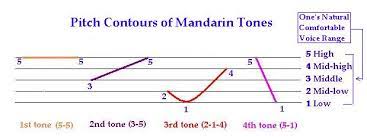The Road to Success. Lower Elementary. Chapter 1
A quick intro to chinese
Chinese is quite different from any european language, as it is both monosyllabic and tonal, neither of which are common attributes in Romanic or Germanic languages. Monosyllabic means that one word is usually only one syllable long, while tonal means that how your voice moves while you speak changes the meaning of the word. One easy example are the two words “to be” 是, pronounced as shi4, with a falling voice, and 十, pronounced shi2, with a rising voice. This counts for every word in Chinese and is why the tone will be indicated in my notes either through Pinyin, a system that indicates the tone of voice with a little line above the first vocal in a word, or through the Wades-Giles Romanization, which is the transcription which uses numbers to indicate tonality.
There are 4 or 5 different tones in Chinese, depending on how one wants to count them and they are sorted as follows:

The fifth tone, not indicated in the chart, is the so called neutral tone. It is a not strongly pronounced tone in the middle of your comfortable vocal range that does not go up or down in pitch. It is spoken shorter than the other tones.
Now that we have discussed the most basic rules of how to transcribe and read chinese, let us start with actually learning it!
The 是 sentence
是(shi4) is a verb that means “to be”. Sentences using it as its predicate are known as 是-sentences. They are used to describe a state of something.
Example: 我是奥地利人。wo3 shi4 ao4di4li4ren2. - I am Austrian.
他是你的朋友吗?ta1 shi4 ni3 de peng2you3.- Is he your friend?
The Pronouns
The pronouns in chinese are as follows:
Singular:
1 我 (wo3) - I
2 你 (ni3) - you
3 他,她 or 它 (ta1) - he,she,it. The pronounciation does not change for any of these three characters. There is no distinguishable difference between male and female in the third person pronoun in spoken chinese.
Plural:
1 我们 (wo3men) - us
2 你们 (ni3men) - you (plural)
3 他们, 她们 or 它们 (ta1men) - they (male, female and neutral form. Neutral form only for things or animals.)